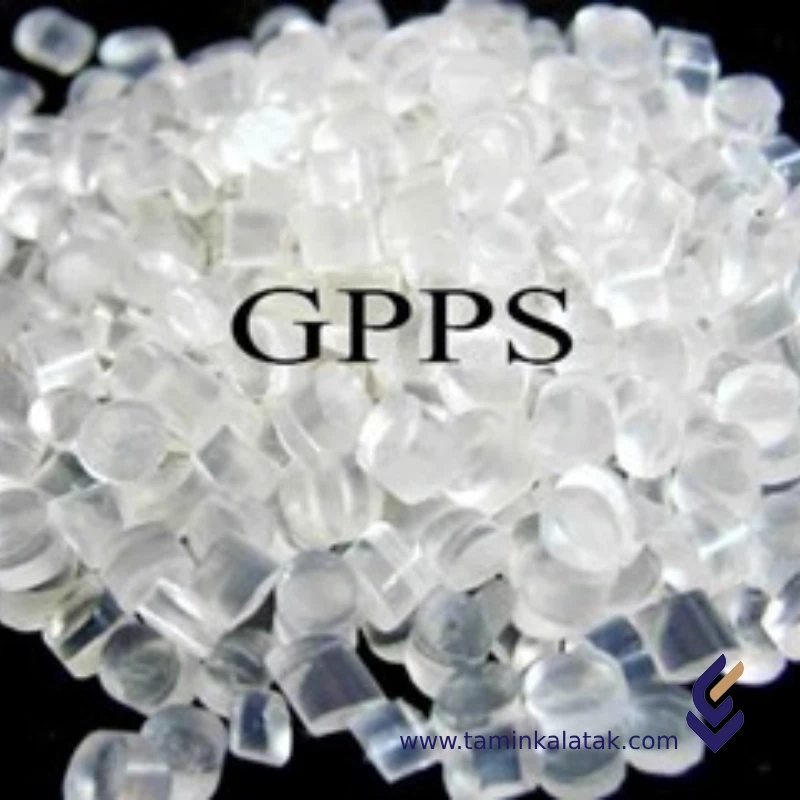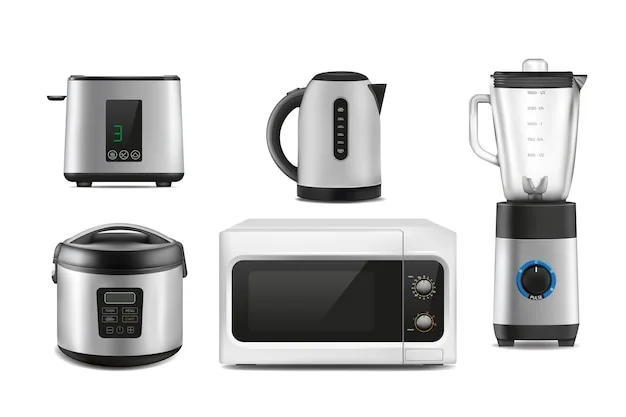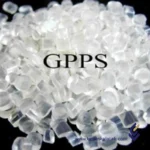Polymers are made up of very large molecules made up of many repeating units called monomers, which ultimately form this long polymer chain
Polystyrene (PS) is a synthetic polymer made from monomers of the aromatic hydrocarbon styrene. Polystyrene can be solid or fomed. General-purpose polystyrene is clear, hard, and brittle. As a thermoplastic polymer, polystyrene is in a solid (glassy) state at room temperature but flows if heated above about 100 °C, its glass transition temperature.and also It has wide applications in various industries including packaging, construction, and automotive.
General Purpose PolyStyrene (GPPS)
General Purpose Polystyrene (GPPS) is produced through the polymerization of styrene monomer via a suspension process. The product is obtained as a solid material and compressed into granules to manufacture a wide range of plastic products. GPPS is characterized by its excellent clarity and high transparency. It is a hard, crystal-clear thermoplastic polymer that is versatile and easy to process. GPPS exhibits excellent electrical insulation, low density, and good dimensional stability. It is widely used in applications such as packaging, household goods, and office equipment.
Structure of GPPS
GPPS is a thermoplastic polymer derived from styrene monomer. The chemical structure of GPPS granules consists of linear chains of styrene monomer units connected by covalent bonds. The properties of GPPS can be modified through copolymerization with other monomers such as acrylonitrile, butadiene, zinc, or methyl methacrylate.
Properties of General Purpose Polystyrene
GPPS has high moisture resistance and excellent electrical insulation properties. However, it is brittle and exhibits low impact strength. Its tensile strength is about 50–60 MPa, and its flexural modulus ranges between 2200–2500 MPa.
The glass transition temperature (Tg) is approximately 85–105 °C, and its melting point (Tm) ranges between 200–240 °C. The heat deflection temperature (HDT) under a load of 0.45 MPa is typically 70–80 °C.
Applications of GPPS
1. Packaging
GPPS is a popular choice for packaging materials due to its excellent clarity, rigidity, and moldability. It is used in the production of food containers, disposable utensils, and CD cases. It is also utilized in blister packaging, commonly used for pharmaceutical products.
2. Consumer Products
Because of its excellent electrical insulation, lightweight, and dimensional stability, GPPS is used in the manufacture of various consumer goods, such as toys, cosmetic packaging, hangers, trays, and household organizers.
3. Construction Industry
GPPS, particularly grade 1540, is used in construction due to its outstanding insulation properties, low weight, and dimensional stability. It is employed in foam insulation boards, window frames, and lighting fixtures.
4. Automotive Industry
In the automotive sector, GPPS is used for producing components such as instrument panels, door panels, and radiator parts because of its moldability and dimensional accuracy.
5. Standard Polystyrene Foam
Standard GPPS foam is a hard, transparent polymer with good thermal and electrical insulation and lightweight properties. Although less impact-resistant than HIPS, it is still widely used across various industries.
Advantages of GPPS
✅ Excellent moldability
✅ Good thermal and electrical insulation
✅ Cost-effective and versatile
✅ High transparency and optical clarity
✅ Stable dimensions
Disadvantages of GPPS
❌ Low impact resistance
❌ Limited thermal stability
❌ Non-biodegradable
GPPS Market Price
The price of GPPS in the market varies depending on brand, delivery location, and market conditions. Due to frequent price fluctuations, it is recommended to consult industry experts for up-to-date pricing information before purchase to ensure a cost-effective buying experience.
GPPS Grades
GPPS 1540
GPPS 1540 is one of the most widely used grades due to its high transparency, easy processability, and glossy surface finish. It is ideal for packaging, household appliances, and laboratory equipment. With its excellent melt flow index (MFI), it is suitable for injection molding and extrusion applications.
GPPS 1551
GPPS 1551 is a rigid, transparent thermoplastic designed for injection molding and component manufacturing. This grade offers high MFI and good thermal resistance, making it ideal for construction, packaging, and household products.
GPPS MP08
GPPS MP08 is a black-colored, UV-stabilized grade suitable for injection and blow molding processes. It contains an optimized carbon black content that enhances surface quality and durability. The supplier ensures consistent quality and long-term reliability for customers.
Production Process of GPPS
1. Styrene Monomer Preparation
Styrene monomer (C₈H₈) is obtained from refining units and purified through fractional distillation to remove organic and gaseous impurities. The industrial-grade styrene must have a purity of over 99% to prevent discoloration and mechanical weakness in the final polymer.
Key steps include:
-
Maintaining distillation temperature between 144–146 °C
-
Testing acid number and oil color index
-
Adding antioxidants (e.g., 4-tert-butylcatechol) to prevent premature polymerization
2. Suspension Polymerization
In this process, styrene monomer droplets are suspended in water with stabilizers and initiators. The main components include:
-
Styrene monomer: 30–40 wt%
-
Deionized water (carrier phase)
-
Suspension agent: gelatin or polyvinyl alcohol
-
Peroxide initiators: benzoyl peroxide or AIBN
Reaction temperature: 60–90 °C under near-atmospheric pressure.
Careful control of temperature, agitation speed, and composition ensures uniform bead size and targeted molecular weight.
3. Separation, Washing, and Drying
After polymerization:
-
Filtration: beads are separated from the aqueous phase
-
Washing: several rinses with deionized water to remove initiator residues
-
Drying: in rotary or fluid-bed dryers at 110–120 °C to achieve <0.1% moisture content
These steps ensure low moisture and high purity, resulting in an easily processable polymer.
Difference Between GPPS and HIPS
Although both belong to the polystyrene family, they differ fundamentally in structure and performance.
GPPS (General Purpose Polystyrene)
A pure homopolymer consisting only of styrene monomer units. It is amorphous, allowing light to pass through easily, giving it excellent clarity. However, it is brittle and has low impact resistance.
HIPS (High Impact Polystyrene)
A copolymer produced by polymerizing styrene in the presence of polybutadiene rubber. The rubber particles act as microscopic shock absorbers, greatly improving impact resistance (5–10× higher) than GPPS.
However, the inclusion of rubber reduces transparency, making HIPS opaque and milky white.
✅ Choose GPPS when clarity and rigidity are priorities.
✅ Choose HIPS when impact resistance and toughness are more important.
Comparison Table: GPPS vs. HIPS
| Property | GPPS (General Purpose Polystyrene) | HIPS (High Impact Polystyrene) |
|---|---|---|
| Alternative Name | Crystal Polystyrene | High Impact Polystyrene (HIPS) |
| Impact Strength | Very Low | High to Very High |
| Transparency | Excellent (up to 90%) | Opaque / Milky |
| Brittleness | High | Low |
| Surface Hardness | High | Medium |
| Flexibility | Very Low | Moderate |
| Softening Temperature | Slightly Higher | Slightly Lower |
| Price | Slightly Cheaper | Slightly More Expensive |
FAQ – GPPS
1. What is GPPS and what are its main properties?
GPPS (General Purpose Polystyrene) is a clear, rigid thermoplastic made by the polymerization of styrene monomer. It features smooth surface, high clarity, easy moldability, and cost efficiency, making it suitable for packaging and consumer products.
2. What is the difference between GPPS and HIPS?
GPPS is transparent but brittle, while HIPS is impact-resistant but opaque, containing rubber additives (polybutadiene) for toughness.
3. In which industries is GPPS used?
GPPS is widely used in:
-
Food packaging and disposable containers
-
Electronic and office equipment
-
Advertising and display materials
-
Laboratory and medical devices requiring transparency
| Prodact | Grade | MFI (g/10 min) | Density (g/cm3) | Vicat Softening Point 50°C/hr(1kg) | process metod | Application / Description | MSDS | Brochure |
|---|---|---|---|---|---|---|---|---|
| General Purpose PolyStyrene | GPPS 1540 | 11 | 1.04 | 89.5 | injection molding, extrusion, thermoforming | Disposable cups and food containers, pen body | ||
| General Purpose PolyStyrene | GPPS 1160 | 2.4 | 1.05 | 105 | extrusion, thermoforming, direct gassing | Foam sheets for thermoforming | ||
| General Purpose PolyStyrene | GPPS 1540 B | 12 | 1.o5 | 91 | method extrusion, injection molding | Disposable cups and food containers | ||
| General Purpose PolyStyrene | GPPS 1460 | 6.5 | 1.04 | 103 | extrusion, injection molding | Extrusion, foamed sheet for tray | ||
| General Purpose PolyStyrene | GPPS 1070 | 1.7 | 1.04 | 104 | method extrusion | ultra HMW for special extrusion | ||
| General Purpose PolyStyrene | GPPS 1240 | 2.5 | 1.04 | 96 | extrusion, injection molding | ultra HMW for special extrusion, injection | ||
| General Purpose PolyStyrene | GPPS 1340 | 4 | 1.04 | 93 | extrusion, injection molding | blister packs, Transparent boxes, clamshell packaging |










